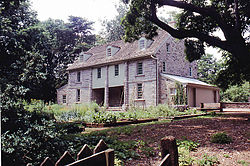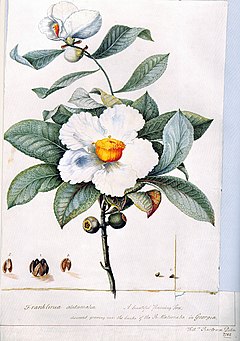Bartram's Garden
John Bartram House | |
U.S. National Register of Historic Places | |
 John Bartram's house and upper garden at Bartram's Garden | |
| Location | 5400 Lindbergh Blvd., Philadelphia |
|---|---|
| Coordinates | 39°55′50″N 75°12′45″W / 39.93056°N 75.21250°WCoordinates: 39°55′50″N 75°12′45″W / 39.93056°N 75.21250°W |
| Built | 1728 |
| Architect | John Bartram |
| Architectural style | Colonial |
| Visitation | 100,000+ per year |
| NRHP reference No. | 66000676[1] |
| Significant dates | |
| Added to NRHP | October 15, 1966 |
| Designated NHL | October 9, 1960 |
Bartram's Garden is a 50-acre public garden and National Historic Landmark in Southwest Philadelphia, Pennsylvania, situated on Lenape territory on the banks of the Tidal Schuylkill River. It is a venue for art, an access to the tidal river and wetlands, an outdoor classroom, and a living laboratory. Founded in 1728 by botanist John Bartram (1699–1777), it is the oldest surviving botanical garden in North America. Bartram’s Garden attempts to hold the colonial legacy of the land with a commitment to learn and share the whole truth about of the plants of Southwest Philadelphia and the people who grow them.
Bartram's Garden has the only recreational access to the Tidal Schuylkill River, and its trails make up segments of the East Coast Greenway. Its John Bowman Bartram Special Collections Library contains a vast collection of documents and materials related to the history of the Garden, the history of Philadelphia, and the development of the field of botany. The Garden is operated by the non-profit John Bartram Association in cooperation with Philadelphia Parks and Recreation.
The garden[]
Colonial American botanist John Bartram founded the garden on his farm in Kingsessing, west of the Schuylkill River and miles outside and south of the what were then the borders of Philadelphia.[2] He built its stone house between 1728 and 1731, added a kitchen around 1740, and installed a Palladian-inspired, carved facade between 1758 and 1770. The house still stands, as does his original garden (circa 1728) and greenhouse (1760). Three generations of the Bartram family continued the garden as the premier collection of North American plant species in the world. They sold it in 1850.
The current collection contains a wide variety of native and exotic species of herbaceous and woody plants. Most were listed in the Bartrams' 1783 broadside Catalogue of American Trees, Shrubs and Herbacious Plants and subsequent editions.[3]


The garden contains three notable trees:
- Franklinia alatamaha (Franklin Tree): William and John Bartram, Jr. encountered a small grove of this tree in October 1765 while camping by Georgia's Altamaha River. William eventually brought seeds to the Garden, where they were planted in 1777. The species, named in honor of John Bartram's friend Benjamin Franklin, was last seen in the wild in 1803. All Franklinia growing today are descended from those propagated and distributed by the Bartrams. They are credited with having saved it from extinction. There are a number of Franklinia on site at Bartram's Garden; the largest is located in the Common Flower Garden to the east of the Bartram House.
- Cladrastis kentukea (Yellowwood): A notably old tree, possibly collected by French plant explorer André Michaux in Tennessee and sent to William Bartram in 1796. This specimen is located by the Kitchen Garden to the east of the Bartram House; there is another large, though younger, specimen slightly further east.[4]
- Ginkgo biloba (Ginkgo): This male ginkgo is believed to be the oldest ginkgo tree in North America, as the last of three original ginkgoes introduced in 1785 to the United States from China, via London. It is located to the east of the Bartram Barn.
Landscape history[]

Bartram's Garden is the oldest surviving botanic garden in the United States. John Bartram (1699–1777), the well-known colonial American botanist, explorer, and plant collector, founded the garden in September 1728 after purchasing a 102-acre (0.41 km2) farm in Kingsessing Township, Philadelphia County. Bartram began his garden by creating a personal landscape.
With his lifelong devotion to plants, he developed it as a systematic collection, as he devoted more time to exploration and the discovery of new North American species and examples. His development both reflected and fostered Bartram's vital scientific achievements and important intellectual exchanges with other botanists. Although it was not the first botanic collection in North America, by the middle of the eighteenth century, Bartram's Garden contained the most varied collection of North American plants in the world. John Bartram also operated a lucrative business centered on the transatlantic transfer of plants.
Following the American Revolution, Bartram's sons William Bartram (1739–1823) and (1743–1812) continued the international trade in plants. They expanded the family's botanic garden and nursery business. Following his father's lead, William became an important naturalist, artist, and author in his own right. Under his influence, the garden became an educational center that aided in training a new generation of natural scientists and explorers. The garden also became well known throughout the young nation. While Philadelphia was the temporary capital, visitors to the garden included members of the Continental Congress in 1784 and President George Washington in 1787.[4] William Bartram's travel book, published in 1791, chronicled his explorations in the South and remains a milestone in American literature.
After 1812, (1779–1858), a daughter of John Bartram Jr., maintained the family garden and business with her husband Colonel Robert Carr (1778–1866) and their son (1804–1839). Their commercial activities remained focused on international trade in native North American plants. Domestic demand also increased under their management, and they established an additional specimen garden to the west of the Bartram House to showcase popular new flowering plants.
In 1850, financial difficulties resulted in the family selling the historic garden to Andrew M. Eastwick (1811–1879), who preserved it as a private park for his estate. Upon Eastwick's 1879 death, a campaign in Philadelphia to preserve the garden was organized by botanist Thomas Meehan (1826–1901). A national campaign for funds was aided by Charles S. Sargent of the Arnold Arboretum in Boston, Massachusetts. In 1891, control of the site was turned over to the City of Philadelphia.
It remains protected as a city park. Since that time, the John Bartram Association, formally organized in 1893, has overseen preservation efforts and historical interpretation of the garden, the John Bartram House, and a number of surviving outbuildings. The garden was designated as a National Historic Landmark in 1960.
The garden's plant collection includes only a few extant examples dating from the Bartram family occupancy; however, documentation for what was once in cultivation is rich. The first century of public ownership left the garden wanting in terms of care and interpretation. Despite the disappearance of a number of subsidiary physical elements in the landscape, the garden's rectilinear framework, designed and laid out by Bartram during the second quarter of the eighteenth century, is still recognizable. In 2011, four acres along the Garden's southern border were established as the Sankofa Community Farm at Bartram's Garden, an African Diaspora-focused crop farm. 2016 marked the opening of the Ann Bartram Carr Garden, a restoration of the 19th-century semi-circular specimen garden to the west of the Bartram House.
Bartram's Garden's physical endurance and resonant associative meanings make the site an unparalleled location for comprehending an array of historical facets related to eighteenth- and nineteenth-century botanic and agricultural studies, John Bartram, the North American plant and seed business, and period domestic life in Philadelphia.
Rambo's Rock[]

Rambo's Rock was a large boulder on the eastern edge of the Schuylkill River, directly across from Bartram's Garden on the plantation of Swedish immigrants Peter and Brita Rambo, just south of Grays Ferry. The rock has disappeared and been replaced with a wharf.[5][6] 39°55′48″N 75°12′29″W / 39.93°N 75.208°W
Representation in popular culture[]
- Diana Gabaldon's novel, Written in My Own Heart's Blood (2014), chapter 24, features the garden as the setting for the reunion of the two main protagonists. This is one of the series known as the Outlander novels.
See also[]
| Wikimedia Commons has media related to Bartram's Garden. |
- Schuylkill River Trail
- Bartram Village
- D. Landreth Seed Company
- List of parks in Philadelphia
- List of National Historic Landmarks in Philadelphia
- National Register of Historic Places listings in Southwest Philadelphia
References[]
- ^ "National Register Information System". National Register of Historic Places. National Park Service. January 23, 2007.
- ^ "Bartram's Flower Garden". Archived from the original on 2014-08-14.
- ^ Bartram, William (1802). William Batram's garden diaries, volume 1. [s.n.] doi:10.5962/bhl.title.146890.
- ^ a b Reid, Robin T. (2010). "The Story of Bartram's Garden". Smithsonian Magazine. Retrieved 2020-08-07.
- ^ Governor's Profile
- ^ Road from Fish House to Maiden Lane, Rambo's Rock V9-LS32.30
Further reading[]
- Fry, Joel T. (January–March 1996). "An International Catalogue of North American Trees and Shrubs: The Bartram Broadside, 1783". The Journal of Garden History. 16 (1): 3–66. doi:10.1080/14601176.1996.10435636.
- Hoffmann, Nancy E.; Van Horne, John C., eds. (2004). "John Bartram and His Garden: Would John Bartram Recognize His Garden Today?". America's Curious Botanist: A Tercentennial Reappraisal of John Bartram, 1699-1777. Philadelphia: American Philosophical Society. pp. 155–183. ISBN 087169249X.
- "HALS No. PA-1, John Bartram House & Garden" (PDF). Historic American Landscapes Survey. Washington, D.C.: Library of Congress. 2004. Archived from the original (PDF) on 2014-02-22.
- Jacobs, James A. (2001). "HALS No. PA-1-A, John Bartram House and Garden, House" (PDF). Historic American Landscapes Survey. Washington, D.C.: Library of Congress. Archived from the original (PDF) on 2014-02-22.
External links[]
- Official website
- Finding aid to the John Bartram Association, records relating to its foundation and early organization at the University of Pennsylvania Libraries
- Historic American Landscapes Survey (HALS) No. PA-1, "John Bartram House and Garden", 57 photos, 4 color transparencies, 5 measured drawings, 136 data pages, 7 photo caption pages
- HALS No. PA-1-A, "John Bartram House and Garden, House", 68 photos, 3 color transparencies, 11 measured drawings, 64 data pages, 8 photo caption pages
- HALS No. PA-1-B, "John Bartram House and Garden, Greenhouse", 22 photos, 1 measured drawing, 17 data pages, 4 photo caption pages
- Historic house museums in Philadelphia
- Biographical museums in Pennsylvania
- Parks in Philadelphia
- Philadelphia Register of Historic Places
- Houses on the National Register of Historic Places in Philadelphia
- 1728 establishments in Pennsylvania
- Botanical gardens in Pennsylvania
- Natural history of the United States
- National Historic Landmarks in Pennsylvania
- Historic American Landscapes Survey in Pennsylvania
- Southwest Philadelphia



